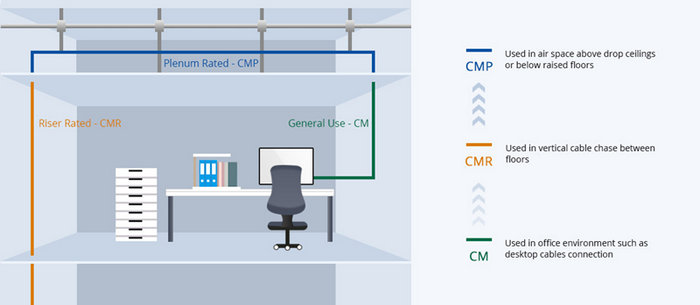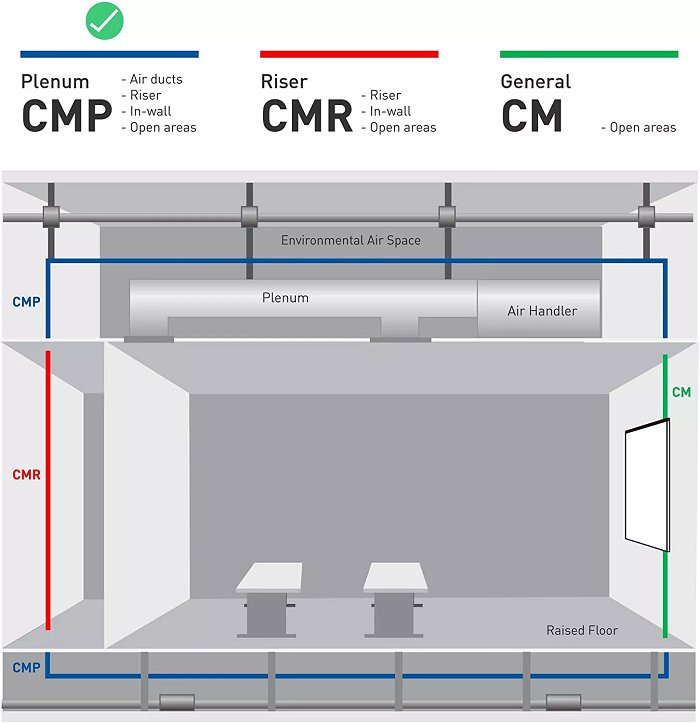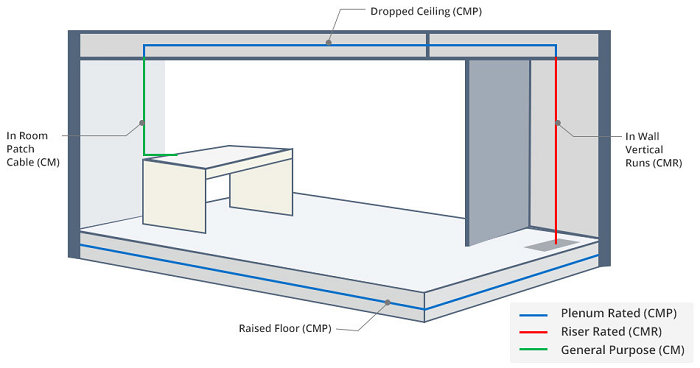Overview
CMP stands for Communications Multipurpose cable Plenum-rated. To reduce the quantity of smoke and harmful fumes generated in the case of a fire, CMP cables are often manufactured with low-smoke, zero-halogen materials. As a result, a plenum cable can be used in air plenum spaces like an air duct, which has a higher fire risk and a potential for dangerous fume and smoke spread.

In comparison, CMR is a Communications Multipurpose cable Riser-rated. The safety and performance standards for usage in vertical runs, including fire safety laws that mandate that riser cables possess fire-resistant properties, are met by CMR cables.
Moreover, a CMR cable is approved for usage in riser applications. Cable runs vertically through a building’s floors, between levels, or via vertical shafts are riser applications.
CM Cable
The usage of cm rated cables is approved for “general purpose” applications but isn’t intended for use in plenum areas or riser applications, which have particular criteria for fire safety. CM cables shouldn’t be utilized in plenum or riser areas since they have different fire protection or smoke suppression qualities than those cables.

Applications
Several low-voltage applications, including those found in residential, commercial, and industrial settings, use CM (Communications Multipurpose) cables. Some of these applications include the following:
- Computer Networking: For Ethernet and other computer network applications, CM cables are often utilized. Devices, including computers, routers, switches, and printers, can be connected via them.
- Audio and video systems: Commercial audio and video systems and home theaters frequently employ CM cables. Additionally, speakers, amplifiers, and other devices can connect via them.
- Security systems: Cameras, alarms, and access control systems are connected using CM connections. Both indoor and outdoor installations are possible with them.
- Telephone systems: CM cables can link telephone systems and other communication equipment.
- Home automation: Lighting controls, thermostats, and other automated equipment can connect via CM connections.
Twisted pair, coaxial, and fiber optic cables, among other topologies, are just a few options for CM cables. It’s crucial to pick and install cables following local construction requirements and safety regulations and the proper type of cable for the application.
CMR Cable
Flame-retardant materials are commonly used to create CMR cables, making them able to withstand the spread of fire along the cable. In the event of a fire, this may delay the spread of smoke and fire throughout a structure and provide more time for evacuation.
Applications
CMR (Communications Multipurpose cable Riser-rated) cables are typically used in vertical applications, or “riser” applications, where the cables pass through different levels or floors of a building. Some of the most common applications of CMR cables include:
- Data centers: In data centers and other installations of IT infrastructure, CMR cables are frequently utilized to link servers, switches, routers, and other networking hardware deployed on several levels or floors of a structure.
- Office buildings: CMR cables link networking and telecommunications systems, including computers, phones, printers, and other office supplies.
- Residential buildings: In residential structures, CMR cables can be utilized for networking, security, and home automation applications.
- Educational institutions: Schools and universities employ CMR cables for networking, audiovisual, and security systems.
- Healthcare facilities: Medical equipment and communication systems in hospitals and other healthcare facilities employ CMR wires.
Twisted pair, coaxial, and fiber optic cables are standard configurations for CMR cables. It is crucial to pick and install cables per local construction requirements and safety regulations and the proper type of cable for the application.
CMP Cable
Application areas where CMP cables are frequently utilized include computer networking, audio and video systems, and security systems. CMP cables come in various arrangements, such as twisted pair, coaxial, and fiber optic cables.
Applications
CMP (Communications Multipurpose Plenum) cables are specifically designed for use in plenum spaces, which are areas in buildings where air circulates for heating, ventilation, and air conditioning (HVAC) systems.
Some of the applications of a CMP cable include the following:
- Office buildings: Office buildings employ CMP cables for networking, phone, and security systems. Computers, phones, printers, and other office supplies can connect via them.
- Educational institutions: Schools and institutions use CMP cables for networking, audiovisual, and security systems.
- Healthcare facilities: Medical equipment and communication systems in hospitals and other healthcare facilities employ CMP cables.
- Government facilities: Government buildings utilize CMP cables for networking, security, and other communication services.
- Data centers: CMP cables are used in plenum spaces to link servers, switches, routers, and other networking hardware.
It’s crucial to pick and install cables per local construction requirements and safety regulations and the proper type of cable for the application. It is crucial to utilize CMP cables that adhere to the relevant fire safety requirements and have the necessary flame resistance and low-smoke emissions features in plenum spaces where fire safety is a concern.
CM vs. CMR vs. CMP: What Is The Difference?
CM, CMR, and CMP are all ratings given to different types of communications cables. The main differences between these ratings are the environments in which they are designed to be used.
While CM cables are suitable for general-purpose applications, CMR cables are suitable for vertical installations, and in comparison, CMP cables are suitable for plenum spaces. When selecting and installing cables, it is important to choose the appropriate type for the application and ensure compliance with local building codes and safety standards.

Therefore, CM cables are suitable for low-voltage applications and aren’t designed for plenum or riser spaces requiring certain fire safety. In comparison, CMR cables are designed for vertical applications, such as cables passing through different floor levels of a building.
On the other hand, CMP is a plenum rated cable meant for plenum spaces and air ducts in buildings because they’re designed to meet strict safety requirements. Moreover, CMP cables are the most fire-resistant cables compared to CM and CMR cables.
What Is PVC, LSZH, OFNR, and OFNP?
Polyvinyl chloride (PVC) is a plastic material used for insulating cables because of its great electrical insulating properties and cost efficacy. This insulation is perfect for cables rated for low-voltage applications such as CM cables.
Low Smoke Zero Halogen (LSZH) is a cable rating that shows the type of insulation and jacket material used to make a cable. The purpose of using this material in cables is to reduce the quantity of smoke and toxic gas emitted in case of a fire. It also prevents the release of halogen gas from a cable.
Optical Fiber Nonconductive Riser (OFNR) is a cable rating that indicates the type of fiber optic cable suitable for vertical riser applications. They’re essential in areas that are a fire safety concern because of the low flammable material they’re made from.
Optical Fiber Nonconductive Plenum (OFNP) is a cable rating used to show the type of fiber optic cable suitable for plenum spaces. Because of the low flammability material, these cables meet the necessary safety requirements for a plenum space.
CM vs. CMR vs. CMP: Which To Choose?
The choice between a CM, CMR and a CMP depends on your needs. The CM will be the best if you’re looking for a cable for general applications. Conversely, the CMR cable would be suitable if you’re looking for the best cable to use in vertical applications.
Further, a CMP cable would be best for use in plenum spaces. Nonetheless, you can always check the national electric code for suitable cable ratings for different applications.
Conclusion
It’s crucial always to consider the fire safety requirements of a building when determining the best cable to use. CM, CMR, and CMP are made from different materials that can affect their efficacy differently. It’s advisable always to consult a professional when deciding on the cables to install in a building.
